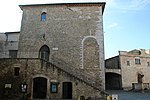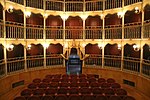Bevagna
| Bevagna | ||
|---|---|---|

|
|
|
| Country | Italy | |
| region | Umbria | |
| province | Perugia (PG) | |
| Coordinates | 42 ° 56 ' N , 12 ° 37' E | |
| height | 210 m slm | |
| surface | 56 km² | |
| Residents | 4,919 (Dec 31, 2019) | |
| Population density | 88 inhabitants / km² | |
| Factions | Cantalupo, Capro, Castelbuono, Gaglioli, Torre del colle | |
| Post Code | 06031 | |
| prefix | 0742 | |
| ISTAT number | 054004 | |
| Popular name | Bevanati | |
| Patron saint | San Vincenzo (June 6th) |
|
| Website | Bevagna | |
 Panorama of Bevagna |
||
Bevagna (Latin Mevania) is since the ancient times existing municipality in the province of Perugia in Umbria and is a member of the association I borghi più belli d'Italia (The most beautiful places in Italy ).
geography
Bevagna is located at 210 m slm in the Valle Umbra on the Topino river, about 150 km north of Rome , 37 kilometers southeast of Perugia and ten kilometers west of Foligno . The Clitunno also flows through the territory of the municipality. Bevagna has a good 1000 inhabitants in the center, i.e. within the historic city wall, together with the incorporated surrounding hamlets (frazioni) there are 4919 inhabitants (as of December 31, 2019).
The districts are Cantalupo, Capro, Castelbuono, Gaglioli and Torre del Colle.
The neighboring municipalities are Cannara , Foligno , Gualdo Cattaneo , Montefalco and Spello .
history
The first traces of settlement can be found in the area of Bevagna from the Iron Age , in ancient times the area was settled by the Umbrians . In 310 BC BC the consul Quintus Fabius Maximus Rullianus broke their power here. The place had (probably since 89 BC) the rank of a municipality . Its pastures near the river and its white oxen are mentioned by Properz , whose family came from Asisium (now Assisi ), and after him by Silius Italicus , Lucan and Statius .
The city is only mentioned again in the 1st century: in the year of the Fourth Emperor in 69 , Emperor Vitellius expected the advance of Vespasian's troops here , which, however, could not be stopped. Due to its important location on the Via Flaminia , the place achieved a certain prosperity until the route of the Flaminia via Terni and Spoleto was moved in the 3rd century. During this time, Christianity penetrated the city, probably through its first bishop and today's patron saint, Saint Vincent of Bevagna.
Bevagna was the early Middle Ages part of the Duchy of Spoleto and 774 the Papal States incorporated. After the turn of the millennium , Bevagna gained communal autonomy under the government of consuls and came under the rule of various signories , including the neighboring city of Perugia . The Dominican (and blessed) Giacomo Bianconi, a pupil of Albertus Magnus , who is now Bevagna's second patron, worked in the city in the late 13th century . Bevagna became part of the Papal States again in 1439 , where it remained until the unification of Italy.
The drainage of the Valle Umbra plays an important role in the history of the city, a process that began in the 15th century, had its first successes in the second half of the 16th century and, in the course of the 19th century, its present shape thanks to drainage systems in the region confers.
Attractions
In the city there are remains of a Roman temple and a Roman theater, which is now overbuilt by medieval houses. The ramparts from Roman times that have now disappeared were - following Pliny (Hist. Nat. Xxxv. 173) - built from unfired bricks. Furthermore, the mosaic with sea creatures from a Roman thermal bath is shown in the city.
The image of the old town, surrounded by medieval walls, is quite uniformly Romanesque . The Piazza F. Silvestri is not only considered to be one of the most beautiful squares in Umbria, but is also famous for its original asymmetrical urban solution.
- San Michele from the late 12th century was rebuilt in Baroque style in 1741 , but partially reconstructed in the fifties of the last century . The two- storey apse and the central portal at the front are particularly worth seeing . Its side walls consist of Roman spoils , which were decorated with motifs from the Middle Ages ( bishop's staff, wickerwork and tendrils). On the two fighters is Archangel Michael shown, left the dragon. The Latin inscription below testifies to "Rodolfus" and "Binellus" as builders, who also
- have built the smaller church of San Silvestro "in the year of the Lord 1195". The upper part of the facade is incomplete. Only a three-arched portal leads into the church, the inner arch of which is decorated with reliefs . In a sitting Drilling window midst of two a lowered Biforien . This corresponds to the staggering of the three-aisled interior: the central nave is barrel-vaulted , the side aisles are provided with a half-ton. As in San Michele, the presbytery is elevated, below is the groin-vaulted crypt . Both rooms close to the outside with the apse.
- The Palazzo dei Consoli , which houses the Teatro F. Torti from 1886, is one of the few remaining communal palaces from the 13th century .
Personalities
- Properz (approx. 48 BC – 15 BC), a representative of the Roman elegance of love
literature
- Klaus Zimmermanns: Umbria . DuMont Buchverlag , Cologne 1987, ISBN 3-7701-1815-4 , pp. 333–336.
Web links
Individual evidence
- ↑ Statistiche demografiche ISTAT. Monthly population statistics of the Istituto Nazionale di Statistica , as of December 31 of 2019.
- ^ I borghi più belli d'Italia. Borghipiubelliditalia.it, accessed August 13, 2017 (Italian).
- ↑ Tacitus , Historien 3,55,3 and 3,59,1.








